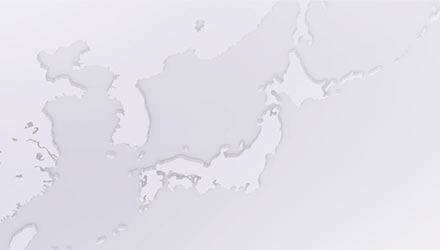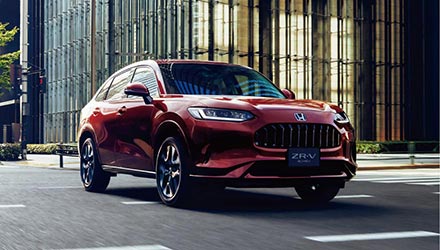Adhering to the Policy to Maintain “Spirited Independence”
in the Midst of the Turbulent Restructuring of
the Automotive Industry
As sales and profits continued to rise, it appeared that the Yoshino presidency was off to a smooth start. However, major tectonic shifts were about to occur deep below these seemingly calm waters. The stormy waves of the times were once again threatening to engulf Honda and the entire automobile industry.
Only a few days after Yoshino’s inaugural press conference, news of a merger between the Germany-based Daimler-Benz AG and the U.S.-based Chrysler swept across the world. Over the years, the world had seen several major international mergers and acquisitions in the automotive industry, such as Ford’s capital participation and partnership with Mazda Motor Corporation in 1974, and GM’s purchase of German automaker Opel as early as 1929. However, the merger of Daimler-Benz and Chrysler, giant automakers representing Europe and the U.S., had much greater impact on the industry. The trend continued as Renault took a major stake in Nissan Motor Co., Ltd. in 1999, and Ford acquired Volvo’s passenger car division in 2000, further strengthening cross-border collaborative relationships among major Japanese, U.S., and European automakers to an unprecedented degree.
In the early 1990s, the fourth president of Honda, Kawamoto felt outrage about (untrue) merger news on Honda, but at the same time, he predicted that the automotive industry was on the brink of an era of global restructuring. His prediction became the reality. Yoshino, who had been working with Kawamoto to solidify the foothold for reform of Honda, was also among the first to experience the upheavals of this new round of industry restructuring.
It was not that Honda was entirely averse to partnering with foreign automakers. In 1979, Honda entered an agreement with one of the leading British automakers, British Leyland Ltd. (later renamed the Rover Group in 1986) to build Honda-based designs in BL factories. From then onward, the two companies strengthened the cooperative relationship in the areas of production and sales and, in July 1989, Honda and Rover agreed on a capital tie-up, which was formalized in April of the following year. Honda supported Rover in the development of new models, which eventually helped Rover to turn around its business performance which had declined. However, the partnership fell apart in only five years. In 1994, BMW suddenly acquired Rover from its parent company, British Aerospace, and the partnership with Honda was dissolved.
In the midst of this great swell of automotive industry restructuring, many of the world’s leading automakers requested a meeting with Honda. Yoshino met with the heads of each company, listened carefully to their proposals, and examined the details. However, he simply couldn’t come to terms with any of the proposals.
“My impression was that they were only talking about extremely managerial matters based solely on the theory of capital. It seemed that they didn’t have a strong belief that the way of life of each and every employee determines the company’s way of being,” said Yoshino.
Takeo Fukui, who later succeeded Yoshino as the sixth Honda president, described Yoshino’s management style: “He was always looking at the ‘people,’ not the things. When he was making a decision to pursue or quit difficult work, he always talked directly to associates ‘at the spot’ who were involved in that particular work. That was not an easy thing to do.” Yoshino was a leader who lived up to his reputation.
“Walking alone or walking hand-in-hand with others [...] I definitely think walking alone will give us greater freedom. One of the strengths of Honda was, and is, speed. [...] To demonstrate our speed, it’s definitely faster to be running alone than running together with other people,” said Yoshino, explaining his decision for Honda to “maintain Spirited Independence.”
At the time, the term “Four-Million Unit Club” was beginning to circulate within the automobile industry, meaning that automakers must have minimum annual production volume of four million units to survive. It was not a scientifically-based number. In the past, some said that automakers with production volume below one million units would go bankrupt, or that automakers should have a minimum production target of two million units. Yoshino was totally unfazed, saying, “Every time we were told this kind of numbers, Honda was producing only about half the volume they say we need to survive.” In fact, Honda automobile production volume at the time was approximately two million units, nearly half of the four million survival threshold.
Many media outlets used the term “Four-Million Unit Club” and asked Yoshino, “Why wouldn’t Honda join the Four Million Unit Club?” Yoshino’s reply was always the same, “Even if there is a basis for the 4 million units, it’s irrelevant to Honda because we produce over 20 million units combining motorcycles, automobiles and power products.” He wasn’t trying to dodge the media’s question. He truly thought, “The Four Million Unit Club is just a numbers game that ignores all conditions that should be considered.”
Building a Global Networking System Through Worldwide
Structural Reform

Global Networking System
At the time, the advantages of being a part of the Four Million Unit Club was explained that automakers could establish a system to complement each other in the areas of parts, products, services and human resources by collaborating with other automakers beyond national boundaries and conducting globalized business throughout the world.
However, Honda was already making progress with its initiatives to establish the four-region global production system and enhance the autonomy of each region based on its policy of “building products close to the customer.” With its policy to maintain “spirited independence,” Honda had achieved globalization without resorting to collaboration with other automakers around the world.
When the demand for automobiles began to rise sharply in some Asian countries in the mid-1990s, Honda was able to quickly prepare human resources, know-how, the production system and parts supply network needed to launch automobile business ahead of other automakers by taking advantage of its experience and know-how accumulated through motorcycle business. For instance, in 1997, the depreciation of the Thai baht triggered a drastic depreciation of other Asian currencies, resulting in the so-called the Asian Financial Crisis. While automakers that had invested in the affected Asian market were hit hard, Honda managed to avoid serious damage by introducing regional motorcycle models and reorganizing its sales network.
Yoshino later explained, “This experience reassured that we don’t need to worry about not being a part of the Four Million Unit Club as we expand our business globally.”
However, Yoshino was also aware that Honda still had a way to go before it could claim to be truly global. In particular, networking among Honda operations was inadequate. At the time, Honda was producing a variety of products at its production operations around the world. However, it hadn’t been able to create a common platform, and technical drawings and production systems were not standardized and parts were procured separately in each region, which was inefficient. While the autonomy of each region should be emphasized, business continuity could be compromised if there were no system to enable regional operations to mutually complement each other without delay in the event that something goes wrong in one or more regions, such as a disaster, accident, political turmoil, or other incidents. Moreover, without a speedy and highly flexible global production system, it would be difficult to meet the needs of customers around the world in a timely manner. Yoshino came to the conclusion that Honda needed worldwide and drastic reform of the production system.
Yoshino later described this reform and said, “It took a considerable amount of time and money.” However, through this reform, Honda eventually centralized its computer and other systems and established a global networking system, which enabled Honda to not only “building products close to the customer,” but also “to realize globally optimized procurement and production to accommodate customer demand.” This reform enabled Honda to manage its global resources more efficiently and embody the concept of “Made by Global Honda.”
The Power of Dreams:
Communicating Honda Global Brand Slogan to the World
Another of the primary focal points of this restructuring of the automobile industry was the joint development of next-generation technologies. It would be easier for automakers to achieve breakthroughs in the development of environmental and safety technologies and to address various societal issues if they could collaborate with multiple automakers with strengths in different technology fields. While knowing that was certainly true, Honda chose to develop next-generation technologies independently with their own hands.
In 1998, the Honda 50th anniversary signaled the start of a company-wide initiative based on the Honda 2010 Vision: To strive to become a company society wants to exist by creating the joys, expanding the joys and ensuring the joys for the next generation. Just as 2001 heralded the dawn of a new century, Honda began communicating its global brand slogan – The Power of Dreams – to the whole world. This brand slogan, which represented the Honda desire to “pursue and realize dreams together with people,” was conveyed to the entire world to express the indomitable will of Honda and the Challenging Spirit.
At the time, unified brand management was not in place at Honda, and logos were being used in different ways by different regions and operations. In order to increase the brand value of Honda and demonstrate the autonomy of Honda operations around the world, a global brand slogan was necessary. Yoshino thus directed the members of the corporate planning meeting to formulate a message Honda should convey as a company.
That was how the slogan, “The Power of Dreams,” was created. Yoshino listened intently to the Committee’s proposal and nodded sagely. The chairperson of this meeting at the time was Takeo Fukui, who would later succeed Yoshino as the president of Honda.

Yoshino left these words for his fellow members of Global Honda: “Logos and words don’t create a brand. I want you to remember that the Honda brand only shines when your wholehearted challenges, your sweat and smiles exist behind our logos and words.”
Yoshino also clearly stated in the 8th mid-term Honda business plan (2002 - 2004): “Honda is transitioning into the next stage as a company, where we will maintain Spirited Independence.” “Spirited Independence is the very way of life Honda has been following for its entire history ever since the founding,” said Yoshino. “Honda has always been a company that takes on difficult challenges. So, we will keep our initiatives high and continue our daily hard work toward our ideals.”
By around 2003, the concept of the Four Million Unit Club, which once created a huge buzz, had already begun to die down. Honda maintained “Spirited Independence” amidst the global restructuring of the automotive industry.
Living Up to its Reputation as a Technology-oriented Company with Hybrid and Fuel Cell Vehicles,
ASIMO and HondaJet
It was around this time that the seeds of new technologies planted by Honda engineers in previous decades began to bear abundant fruit.
In November 1999, Honda launched its first hybrid vehicle, the Insight, which achieved the world’s best*1 fuel economy of the time with 35km/litter (5MT type measured in 10 and 15 mode).
In July 2002, the Honda FCX became the world’s first hydrogen fuel cell vehicle certified by both the U.S. Environmental Protection Agency (EPA) and the California Air Resources Board (CARB) for commercial use.
Upon mention of the EPA, Honda went through the EPA certification process a while ago with the CVCC engine. In 1972, the Honda CVCC engine itself cleared the 1975 emission regulation standards set forth by the U.S. Clean Air Act of 1970, and then, in 1974, Honda Civic equipped with the CVCC engine was certified by the EPA.
While the development of this epoch-making low-pollution engine was proceeding at a rapid pace, Yoshino was assigned the responsibility of conducting in-depth research on and gathering information related to air pollution controls in the U.S. and played an important role in making Civic the world’s first automobile to obtain EPA certification as a vehicle that cleared the 1975 standards of the U.S. Clean Air Act of 1970. It must have been a special experience for Yoshino to see the FCX receiving another world’s first EPA certification after 30 years.
Yoshino sent a shout-out and words of encouragement to Honda engineers: “I believe what’s most important is the fact that we are ushering in a new era of next-generation engines with technologies we’ve developed and that we continue to carve out the future of mobility through our own hard work, sweat, and getting our hands greasy.”
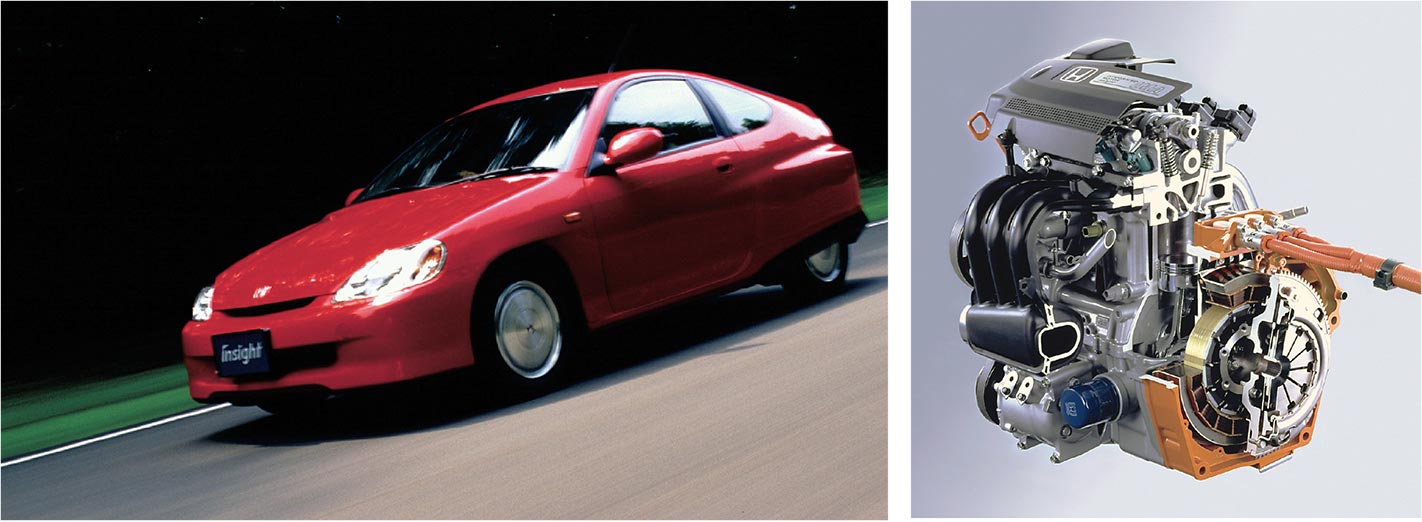
The Insight, the first Honda hybrid vehicle equipped with the IMA system.
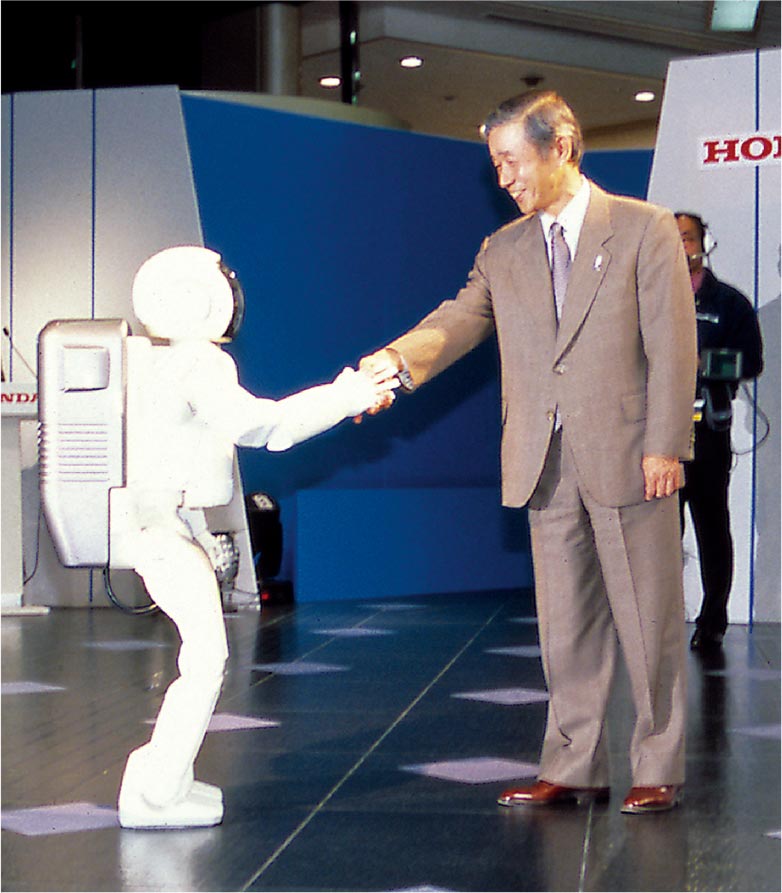
In the field of robotics, Honda unveiled ASIMO, the humanoid robot, in 2000. The development of bipedal robots began at Honda in 1986 with an exploration of the principles of bipedal walking. After advancing robotics technologies with several Honda E series robots, which were developed exclusively for the study of bipedal walking, the P1, the first Honda humanoid robot prototype was completed in 1993. After further advancement through multiple P series robots, ASIMO was created.
“I was convinced that humanoid robot technology would definitely help people. I became the first Honda president who worked with ASIMO,” said Yoshino with a big smile on his face.
ASIMO gained worldwide popularity as a symbol of the progressiveness of Honda at the start of the 21st century. About 20 years after its debut, Honda concluded the development of ASIMO; however, during its 20-year career, ASIMO traveled to more than 25 countries around the world and experienced many things, such as conducting the Detroit Symphony Orchestra, and visiting people in areas devastated by the Great East Japan Earthquake and Tsunami. The robotic technologies applied to ASIMO, such as walking assist and balance control technologies, have since applied to Honda products and technologies in various fields.
Another area where the seeds of technologies sown earlier bore fruit was in the field of aviation. Honda began research on small aircraft and jet engines in 1986, the same year as the development of fuel cell technology and bipedal humanoid robots began. More than a decade later, in 2003, Honda developed the experimental model of the HondaJet, a compact business jet, and began initial flight tests. Another decade later, in 2015, Honda began customer deliveries of the HondaJet shortly after receiving type certification from the U.S. Federal Aviation Administration (FAA). The HondaJet was well received by customers around the world and was the most delivered aircraft in its class for five consecutive years until 2021. The Honda dream of developing light jets in the future, which attracted Yoshino to join the company, finally had become reality.
- As of 1999. (Honda internal research)
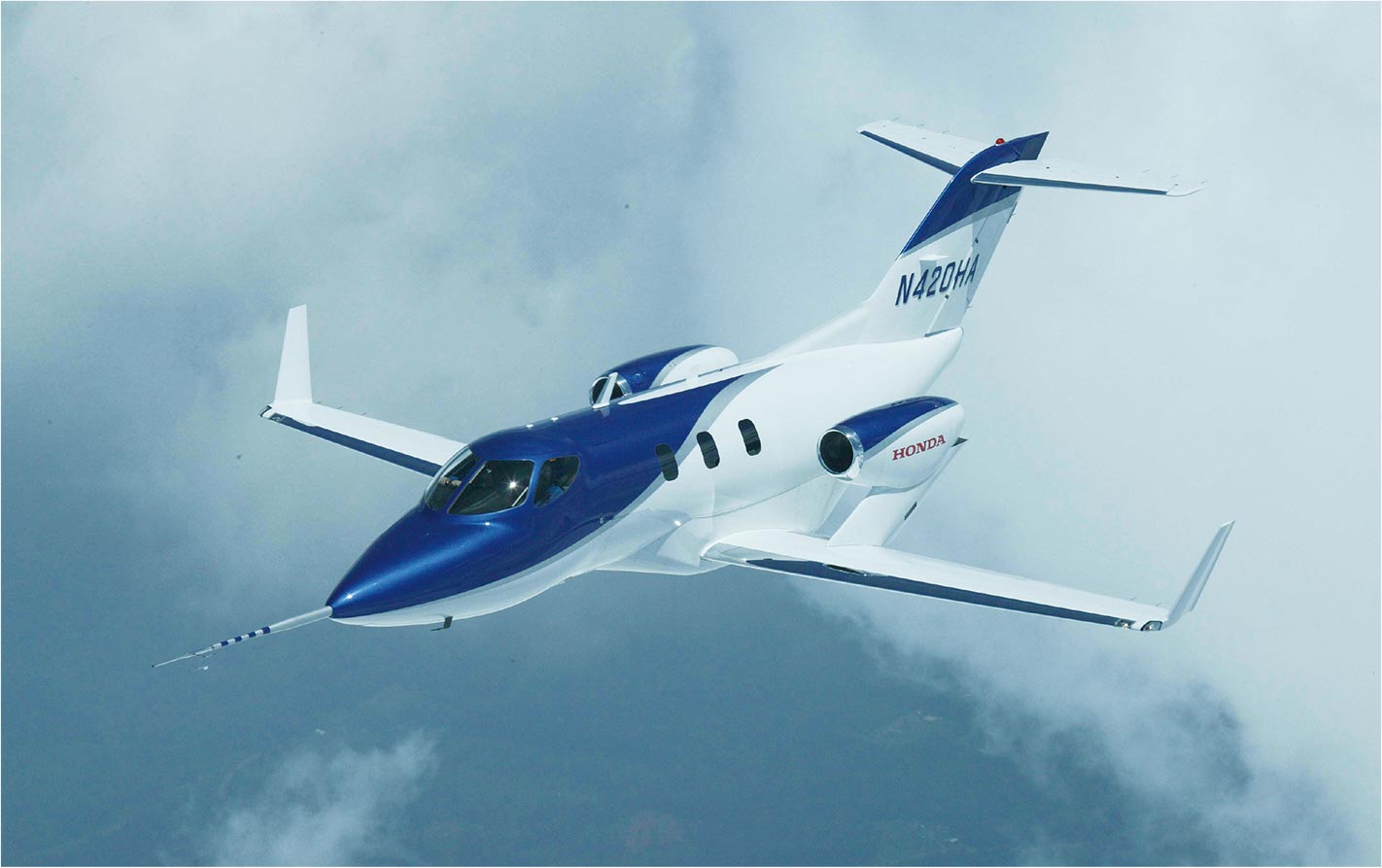
HondaJet
The Fit Became a Game-Changer in Compact Car Category
where Honda was Struggling
A particularly noteworthy event in Honda automobile business during this period was the introduction of the Fit, which won both the 2001- 2002 Japan Car of the Year and the 2002 RJC Car of the Year Awards.
In contrast to the strong sales of the Creative Mover series models, Honda had been struggling for some time in the compact car category, which was originally considered a specialty of Honda. Yoshino had a serious concern that failing to demonstrate its true strength in this category would eventually damage the image of the Honda brand, which will put Honda in a difficult situation. To address this concern, Yoshino took charge and re-organized and prioritized ongoing R&D projects so that Honda R&D could focus on the development of the Fit, a compact car that represents the unique characteristics of Honda. Yoshino took on a management role himself, and entrusted Takeo Fukui, the President of Honda R&D at the time, to lead the operations at the spot.
Fukui recalled, “Mr. Yoshino’s management style was that he talked with the team members until he became fully satisfied and made a management decision at the top, then left everything up to the associates at the spot [...] but he still took full responsibility for whatever resulted. The Fit development team was fully motivated thanks to Mr. Yoshino’s style of management.”
Released in June 2001, the Fit become an unprecedented hit and the best-selling model in Japan in 2002, overtaking Toyota Corolla, which had been in first place for 33 years straight.

The first-generation Honda Fit (2001)


